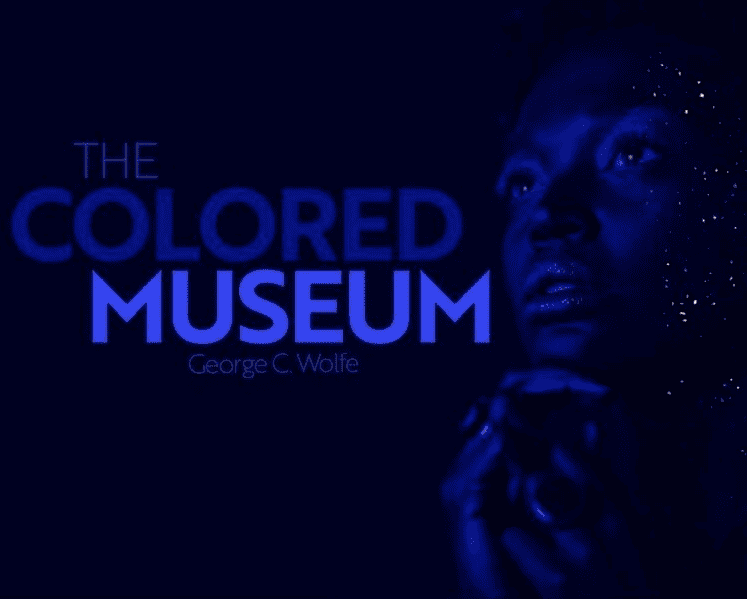How ‘The Colored Museum’ examines the Black experience in America
February 9, 2022
The University of Alabama’s theater department began Black History Month with a week of performances of “The Colored Museum,” a play written by George C. Wolfe that examines what it means to be African American.
Although the play was originally published in 1987, all of the skits handle topics that are still discussed today in Black spaces, from how Black members of the LGBTQ community are treated to what it takes to excel in corporate spaces while being Black.
Each actor tackles the material Wolfe wrote, exploring themes while making use of songs by Black artists between each skit.
The set is minimal: only two large multicolored movable walls that hide the backstage of the Allen Bales Theater. There are props that set the scenes, but the standout work comes from the actors who play each character with dignity.
Members of the all-Black cast were double- or triple-casted in roles. Every actor and actress embodies different characters.
Marcus Johnson, a junior majoring in musical theatre, plays three roles: Miss Roj, in “The Gospel According to Miss Roj,” a skit about the experience of being queer and Black; Mama, in “The Last Mama on the Couch Play,” a skit that satirizes stereotypes found in media directed at Black people; and The Kid in “Symbiosis,” where Johnson plays the younger self of a man who’s trying to throw his past away to get ahead in white America.
“One role that I did spend the most time on was Miss Roj, the drag queen of the show. Though all of these characters are complex, Miss Roj has a complexity which is very hard to grasp at first glance. Being a queer Black performer myself, I have firsthand experience on what it’s like to experience that sort of discrimination,” Johnson said.
The material in Wolfe’s play is heavy. Despite the satire that brings moments of levity, the objective of the play is to make people think, to make people uncomfortable. That includes the actors. To be uncomfortable means Wolfe did something right.
“The most difficult part of working on ‘The Colored Museum’ was talking about and expressing the effects of trauma onstage while still currently experiencing it offstage in a white society,” Johnson said.
Tackling roles like the ones in “The Colored Museum” is not easy, but Johnson felt satisfied by the process in the end.
“The most fulfilling part of this experience was getting to work on a stage show with my first all-Black cast,” Johnson said. “There is nothing like being able to truly and deeply connect with people from the same background as you. They know you, understand you, love you and are fighting for you every step of the way.”
While Johnson and the other actors bring the characters to life onstage, they are helped by the direction of the offstage team. Lighting, sound, props, makeup, and hair and costumes bring the show together.
Katarina Kristensen, a master’s candidate in costume design and production, oversaw the costuming for the play. A part of her job is studying the material to figure out what look will work best for each role.
A costume that left an impression was a retro flight-attendant uniform worn by Trinity Ross, a junior majoring in theater, for the “Miss Pat” skit. The stewardess outfit was blue. White gloves completed the nostalgic look.
“When you create costumes for theater you finish creating the character for the actor,” Kristensen said. “I think the exchange of trust between two artists, the costume designer and the actor, is such a beautiful thing. We interchangeably make each others’ artistry come to life.”
“The Colored Museum” has costuming that includes sequins, colors and prints. Some of the sketches are products of their time.
For example, “The Photo Session” is a critique of Ebony magazine, which peaked in popularity in the late ’80s and early ’90s. The outfits are glamorous and flashy. Aliayah Coleman, a senior majoring in accounting, wears a long gown, and Christopher Watts, a sophomore majoring in theater, wears a nice suit. Onstage they describe a shiny, superficial life as a model to cover up internal pain.
The costuming reflects the time and mood of each skit. Storytelling is at the heart of costumes.
“I like to read the play three times because the first read is meant to be enjoyed, second read is for logical reference — where are they, who is there, what time of day, and how much time has passed — and then the third time for clothing wordage or meaning,” Kristensen said.
Productions like the one behind this play are unfortunately not common. Very rarely do you see this many Black people on and off the stage working on a show.
Christian Tripp, the director of the show, also teaches classes at the University about African American performance in theater and its underrepresentation in popular culture. The objectives include gaining a richer understanding of African American entertainment, past and present.
“We have to fight for shows like this to be remembered, let alone put on,” Tripp said. “I use this as a teaching moment for my students on and off the stage.”
Putting on a play like “The Colored Museum” is important because it gives light to art that often gets overlooked for works that do not showcase Black talent and Black stories.
Questions? Email the Culture desk at culture@thecrimsonwhite.com.








